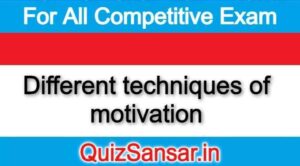
Different techniques of motivation
The following are the Motivational Techniques :
(1) Job design: The design of an employee’s job can have a significant effect on their job motivation. Job design includes designing jobs that create both a challenging and interesting task for the employee and is effective and efficient for getting the job done. Four approaches to job design are:
(i) Job Simplification: The goal of this job is to standardize and specialize tasks. Unfortunately this approach does not always lead to increased motivation as the jobs can become mundane.
(ii) Job Enlargement: The goal of this job design approach is to combine tasks to give the employee a greater variety of work.
(iii) Job Rotation: The goal of this job design approach is to move workers to different tasks periodically.
(iv) Job Enrichment: The key to job design employee motivation, this approach aims to enhance the actual job by building up the employee through motivational factors.
(2) Rewards – Using rewards as motivators divides employee motivation into two categories. Intrinsic and extrinsic motivation. Intrinsic rewards are internal, psychological rewards such as a sense of accomplishment or doing something because it makes one feel good. Extrinsic rewards are rewards that other people give to you such as a money, compliments, bonuses, or trophies.
Many studies have been conducted concerning how motivation is affected by rewards resulting in conflicting and inconsistent outcomes. Pierce, Cameron, Bank, and So conducted a study to examine how extrinsic rewards affect people’s intrinsic motivation when the rewards are based on increasingly higher performance criteria. Pierce et al found that rewarding people for meeting a graded level of performance which got increasingly more difficult, spend more time on the study’s activities and experienced an increase in intrinsic motivation. Participants who were not rewarded at all or only rewarded for maintaining a constant level of performance experienced less intrinsic motivation. Another study that examined the effects of extrinsic rewards on intrinsic motivation was conducted by Wiersma. Wiersma conducted a meta-analysis to summarize the inconsistent results of past studies. The meta-anlaysis by Wiersma concluded that when extrinsic rewards are given by chance, they reduce intrinsic motivation.
(3) Intrinsic rewards: Job Characteristics Model : The Job Characteristics Model (JCM), as designed by Hackman and Oldham attempts to use job design to improve employee intrinsic motivation.
They show that any job can be described in terms of five key job characteristics :
(i) Skill Variety: The degree to which the job requires the use of different skills and talents.
(ii) Task Identity: The degree to which the job has contributed to a clearly identifiable larger project
(iii) Task Significance : The degree to which the job affects the lives or work of other people.
(iv) Autonomy: The degree to which the employee has independence, freedom and discretion in carrying out the job.
(v) Task Feedback: The degree to which the employee is provided with clear, specific, detailed, actionable information about the effectiveness of his or her job performance.
The JCM links the core job dimensions listed above to critical psychological states which results in increased employee intrinsic motivation. This forms the basis of this “employee growth-need strength.” The core dimensions listed above can be combined into a single predictive index, called the Motivating Potential Score.
(4) Employee participation:
(i) Increase employee participation by implementing quality control ‘circles’: Quality control circles involve a group of five to ten problem solving employees that come together to solve work-related problems such as reducing costs, solving quality problems, and improving production methods. Other benefits from quality control circles include an improved employee-management relationship, increased individual commitment, and more opportunities for employee expression and self-development.
(ii) Increase motivation through employee participation by using open book management: Open-book management is when a company shares important financial data with employees. Sharing the information empowers employees by putting trust into them. Employees become personally and meaningfully involved with the organization beyond just doing their assigned tasks, which increases their motivation and production. Open book management is a four step process. The first step involves employers sharing financial data with their employees. Employees need to know how the company, as a whole, is doing financially. Next, employers must teach their employees how to read and interpret the financial data. Employees can look at all the data a company gives them. However, to understand the data, they must know how to interpret the numbers. Third, employees have to be empowered to make necessary changes and decisions for the success of the organization. Employers should treat their employees like partners. The last step involves employers paying their employees a fair share of profits through bonuses and incentives. Four factors must exist for any employee participation program to be successful :
(a) Have a profit-sharing or gain-sharing plan where both the employer and employee benefit.
(b) Implement a long-term employment relationship to instill job security.
(c) Make a concerted effort to build and maintain group cohesiveness.
(d) Provide protection of the individual employee’s rights.
(5) Quality-of-work-life programs: Work-life balance is an employee’s perception of how a proper balance between personal time, family care, and work are maintained with minimal conflict. Employers can use work-life balance as a motivational technique by implementing quality-of-work-life programs. Examples of such programs include flextime, workplace wellness, and family support. Flexible work schedules can allow an employee to work whenever they can as long as a certain amount of hours are worked each week and some employers allow their employees to work from home. Sometimes employers utilize flextime schedules that allow employees to arrive to work when they choose within specified limits. A wellness program can involve having an exercise facility, offering counseling, or even having programs set up to help employees lose weight or stop smoking cigarettes. Family support programs involve help with parenting, childcare, and some programs allow employees to leave for family purposes.






